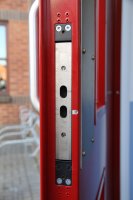Access Control Locks
- Telephone or video entry system overseen by a receptionist or security guard - (press button to release)
- Numerical keypad, proximity reader, swipe card, or biometric reader (finger, face, voice etc)
- Fire alarm
To be part of a building’s access control system, doors need to be fitted with an electrically operated locking mechanism. DoorTechnik doors may be fitted with maglocks, shearlocks, electric strikes, or motorised locks, which will connect to most commercial access control systems running at 12V or 24V.
Lock choice is determined by the powered or unpowered lock behaviour, and by the door type.
In general:
- Maglocks and shearlocks unlock when power is withdrawn (fail unlocked)
- Electric strikes and motorised locks are normally selectable to be either locked or unlocked when power is withdrawn
- Escape doors must be unlocked when power is withdrawn
- Fire doors and security doors are locked when power is withdrawn
Locks should be specified, configured and controlled to suit the door types as follows:
|
Door Type |
Unpowered lock state |
Suitable access controlled locks |
|
All escape doors, whether fire doors or security doors or not |
Unlocked |
Maglock, shear lock. Electric strike or motorised lock, when set to fail unlocked. |
|
Non-escape doors fire doors Non-escape security doors |
Locked |
Electric strike or motorised lock, when set to fail locked. |
Note that escape door functionality take precedence over that of fire doors and security doors, so that escape doors of any type must unlock when unpowered.
For the UK, further guidance concerning escape doors and their locking systems, and fire doors, may be found in the following publications:
The Building Regulations 2010, Approved Document B
The Building Regulations 2010, Approved Document B1, 5.10 Doors on escape routes, 5.11 5.12 Door fastenings

Maglock
|
Shearlock |
Electric Strike |


 +44(0)1522 693522
+44(0)1522 693522 info@doortechnik.co.uk
info@doortechnik.co.uk
